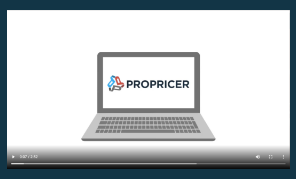In government contracting, the allure of lucrative opportunities often comes with a shadowy companion known as risk.
Government proposal processes can resemble a complex dance, requiring delicate balance and strategic finesse—and the need to keep an eye on that unpredictable component constantly.
Here, we'll navigate a few solutions to risk management in government contracting, with the help of real-life examples and keen insights, to help you ensure your potential for reward outweighs your level of exposure.
Invest 10,000 hours in your craft
The "10,000-hour rule," as popularized by Malcolm Gladwell's book "Outliers," posits that around 10,000 hours of dedicated practice are required to attain mastery in a specific field. This principle suggests that sustained effort, deliberate learning, and continuous improvement over an extended period are necessary to achieve exceptional expertise.
While not exclusive to any particular domain, this rule emphasizes rigorous commitment and training to realize high levels of competence. In the context of government contracting, this rule can symbolize the extensive effort needed to fully understand the industry's intricacies, from regulations and proposal processes to building solid relationships and navigating complexities effectively.
Consider the case of Lockheed Martin's proposal for the F-35 Joint Strike Fighter program. This monumental undertaking required exhaustive research, collaborative effort, and a keen understanding of Lockheed's agency customer's needs. By committing to the 10,000-hour rule of mastery in their proposal process, Lockheed Martin navigated the risk put forth by their competition and secured a contract that would reap the rewards for decades to come.
Anticipate gaps through demand-driven efforts.
But sometimes, even if you've culled your proposal process to perfection during years of practice, your materials can falter, leaving you with service and delivery interruptions. After a series of months-long delays, The Pentagon is again accepting new F-35 Joint Strike Fighters from Lockheed Martin, a spokesman for the F-35 Joint Program Office said in a statement, lifting a pause put in place after an accident in December 2022.
Before acceptance, the new, about-to-ship aircraft passed extensive technical and flight-worthy checks, ensuring its readiness for operational use.
What saved Lockheed from the risk of overusing materials and labor during the pause? Most likely a demand-driven manufacturing approach to building the F-35s.
This approach, at first glance, seems counterintuitive. Instead of manufacturing goods in vast quantities in anticipation of what its agencies might want, Lockheed probably responded directly to the immediate demands of the market. Lockheed minimizes waste and excess inventory risks by syncing its rhythms with real-time agency wants and needs.
The David and Goliath paradigm: Embrace your uniqueness
If you're a smaller contracting firm, a standard risk mistake is trying to mirror the strategies of industry giants. But David defeated Goliath not by emulating the giant but by playing to his unique strengths. Likewise, in government proposals, the magic often lies in highlighting what makes your firm distinctive.
Take the case of Novatech Solutions, a small IT consulting firm that secured a multi-million-dollar contract with a federal agency. Instead of attempting to outmuscle larger competitors, Novatech wisely highlighted its nimbleness, personalized approach, and innovative solutions. By embracing their uniqueness, they stood out in a crowded field, turning their small size into a significant risk advantage.
Consider The Law of the Few
A few select individuals hold disproportionate influence in disseminating ideas and awarding business. In the government contracting arena, these influencers could be the key relationships that act as catalysts in tipping your scales toward success—instead of toward outsized risk—in contract awards.
Consider Amazon's bid to provide the Central Intelligence Agency (CIA) with cloud computing services. Jeff Bezos's connections and the technological prowess of Amazon Web Services played pivotal roles in tilting the balance in their favor. By leveraging the Law of the Few, Amazon transformed risk into reward, securing a game-changing contract that changed the company's trajectory and reshaped the government contracting landscape.
You can do the same, albeit more modestly, by developing influential relationships at every agency tier before engaging in contract competition.
The power of the unthinkable: Embracing the Blue Ocean Strategy
Consider unconventional approaches that break the mold. Embracing what's called a Blue Ocean Strategy could be your key to turning risk into a contracting opportunity.
A prime example is SpaceX's audacious bid to disrupt the launch services market dominated by established players. By innovatively reusing rocket components and significantly lowering costs, SpaceX created a blue ocean of untapped potential. The "unthinkable" approach allowed them to mitigate the risks of entering a fiercely competitive market and positioned them as a game-changer in government satellite launches.
The Stickiness Factor: Crafting Compelling Proposals
The Stickiness Factor emphasizes the importance of making ideas memorable and resonant. In the realm of government proposals, crafting a compelling narrative that sticks in your evaluators' minds can be your catalyst to success.
Consider Apple's iconic "1984" Super Bowl commercial, a masterclass in the stickiness factor. As a contractor, you should aim to create a similarly unforgettable impact when drafting proposals. By crafting a storytelling narrative that addresses the client's pain points, showcases innovative solutions, and communicates a clear value proposition—directly or through powerful metaphor— a proposal gains the stickiness necessary to stand out amidst the competition.
The role of serendipity: Remaining agile in a shifting landscape
Serendipity teaches us to recognize and seize unexpected opportunities. In government contracting, this means maintaining agility in the face of ever-changing landscapes.
Consider the case of Palantir, which seized a serendipitous moment presented by the COVID-19 pandemic. By rapidly adapting its data analysis tools for the pandemic response, Palantir demonstrated its agility and showcased its commitment to the greater good. This agility helped them navigate uncertainty, mitigate potential risks, and secure critical data analysis services contracts.
The Goldilocks Zone: Crafting a Compelling Proposal
Much like the tale of Goldilocks, government proposals must strike the right balance—not too little, not too much, but just right. Government evaluators are inundated with proposals, and wading through verbose documentation is hardly their idea of a good time. The key is to present information succinctly and persuasively.
Consider the example of Vanguard Engineering, a firm that secured a prime contract by crafting a proposal that was as concise as it was impactful. They artfully combined relevant project experience, key personnel bios, and a clear project plan into a streamlined narrative. The result? Evaluators were able to grasp the proposal's merits swiftly, making a compelling case for Vanguard's capabilities without drowning them in unnecessary details.
The power of storytelling: Weaving a narrative of success
As humans, we are hardwired for stories. They resonate deeply, allowing us to connect emotionally and intellectually. The same principle applies to government proposals. Beyond the technical jargon and figures, a well-tuned narrative can be the secret weapon that elevates your proposal from mundane to memorable.
Look no further than the case of GreenScape Environmental, a company specializing in sustainable land management. Their proposal to an urban welfare agency didn't merely outline their services and expertise; it painted a vivid picture of transforming neglected urban spaces into thriving ecosystems.
GreenScape's proposal stood out in the evaluators' minds by evoking a sense of purpose and impact, demonstrating that a compelling story can be the difference between a contract won or lost.
Calculated risks: Flexibility in approach
In government proposals, risk management doesn't have to be about eradicating risks but instead can be about embracing calculated risks that demonstrate adaptability and forward-thinking.
Take the example of AeroDynamics, an aerospace firm that secured a critical defense contract by embracing innovative yet unproven technology. While the risk of untested technology was palpable, AeroDynamics presented a robust mitigation plan and an unwavering commitment to research and development. By showcasing their willingness to tread new ground, they displayed calculated risk-taking that resonated with the evaluators and ultimately paid off.
The symbiosis of collaboration: Leveraging partnerships
A partnership can be the dynamic duo that saves your day. Collaboration with other firms, subcontractors, or research institutions can amplify your proposal's strength, providing agency readers with a sense of collective expertise.
A prime example is QuantumTech, a firm specializing in advanced cybersecurity. Instead of relying solely on its in-house capabilities, QuantumTech strategically partnered with a leading university's cybersecurity research center, showcasing a commitment to harnessing the brightest minds in the field. This symbiotic partnership bolstered their proposal's technical credibility and demonstrated a dedication to pushing the envelope in their domain.
ProPricer: Your ultimate ally in mitigating proposal risk
Imagine a software tool that acts as your advisor, guiding you through the fog of uncertainties and complexities during the contract process and allowing you to confidently navigate iterative BOE narratives and statistical components, cost models, analysis comparisons, and much more. Enter ProPricer Contractor Edition – a game-changer that transcends the mundane and becomes the strategic compass in your arsenal against proposal-turnaround risk.
ProPricer deftly streamlines proposal processes, giving you the gift of time to focus on more strategic dimensions of your contract management.
The hours recouped by embracing ProPricer Contractor Edition can be where your strokes of genius set you apart – the crucial junctures where instinctual decisions happen and risks morph into possibilities. Contact us for a demo >
Sources
- Book: The Tipping Point
- Book: David and Goliath
- Book: Blink
- Book: Outliers
- Breaking Defense Article: Pentagon resumes acceptance of F-35s from Lockheed Martin following a months-long pause





